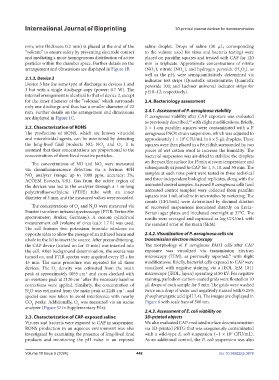Page 456 - IJB-10-5
P. 456
International Journal of Bioprinting 3D-printed plasma devices for decontamination
mm; wire thickness: 0.2 mm) is placed at the end of the saline droplet. Drops of saline (30 μL; corresponding
“volcano” to ensure safety by preventing electrode contact to the volume used for virus and bacteria testing) were
and mediating a more homogeneous distribution of active placed on parafilm squares and treated with CAP for 120
particles within the chamber space. Further details on the min in triplicate. Approximate concentrations of nitrite
arrangement and dimensions are displayed in Figure 1B. (NO ), nitrate (NO ), and hydrogen peroxide (H O ), as
-
-
2
2
2
3
well as the pH, were semiquantitatively determined via
2.1.3. Device 3 indicator test strips (Quantofix nitrate/nitrite; Quantofix
Device 3 has the same type of discharge as devices 1 and peroxide 100; and Lachner universal indicator strips for
3 but with a single discharge copy (power: 0.7 W). The pH 0–12, respectively).
internal arrangement is identical to that of device 2, except
for the inner diameter of the “volcano,” which surrounds 2.4. Bacteriology assessment
only one discharge and thus has a smaller diameter of 22
mm. Further details on the arrangement and dimensions 2.4.1. Assessment of P. aeruginosa viability
are displayed in Figure 1C. P. aeruginosa viability after CAP exposure was evaluated
as previously described, with slight modifications. Briefly,
10
2.2. Characterization of RONS 1 × 1-cm parafilm squares were contaminated with a P.
The production of RONS, which are known virucidal aeruginosa PAO1 strain suspension, which was adjusted to
and microbicidal agents, can be monitored by detecting approximately 1 × 10 CFU/mL in 6 × 5-µL droplets. These
7
the long-lived final products NO, NO and O . It is squares were then placed in a Petri dish surrounded by two
2,
3
assumed that their concentrations are proportional to the pieces of wet cotton wool to increase the humidity. The
concentrations of short-lived reactive particles. bacterial suspension was air-dried to stabilize the droplets
The concentrations of NO and NO were measured on the parafilm surface for 15 min at room temperature and
2
via chemiluminescence detection via a Serinus 40H subsequently exposed to CAP for 1, 5, 10, and 30 min. The
NO analyzer (range: up to 1000 ppm; accuracy: 2%; samples at each time point were tested in three technical
x
ACOEM Ecotech, UK). Gas from the active region of and three independent biological replicates, along with the
the devices was led to the analyzer through a 1 m-long untreated control samples. Exposed P. aeruginosa cells (and
polytetrafluoroethylene (PTFE) tube with an inner untreated control samples) were collected from parafilm
diameter of 3 mm, and the measured values were recorded. squares into 1 mL of saline in microtubes by vortexing. The
counts (CFU/mL) were determined by decimal dilution
The concentrations of O and N O were measured via of recovered suspensions inoculated directly on Luria–
3
2
Fourier transform infrared spectroscopy (FTIR; Vertex 80v Bertani agar plates and incubated overnight at 37°C. The
spectrometer; Bruker, Germany). A custom cylindrical results were averaged and expressed as log CFU/mL with
measurement cell (volume of circa (ca.): 1.7 L) was used. the standard error of the mean (SEM).
The cell features two potassium bromide windows on
opposite sides to allow the passage of an infrared beam and 2.4.2. Visualization of P. aeruginosa cells via
a hole in the lid to insert the source. After preconditioning, transmission electron microscopy
the CAP device (turned on for 15 min) was inserted into The morphology of P. aeruginosa PAO1 cells after CAP
the cell. After background determination, the source was exposure was visualized via transmission electron
54
turned on, and FTIR spectra were acquired every 15 s for microscopy (TEM), as previously reported, with slight
15 min. The same procedure was repeated for all three modifications. Briefly, bacterial cells exposed to CAP were
devices. The O density was estimated from the main visualized with negative staining via a JEOL JEM 1011
3
peak at approximately 1055 cm and cross-checked with microscope (JEOL, Japan) operating at 80 kV. For negative
-1
an overtone peak at 2120 cm after the necessary baseline staining, parlodion-carbon-coated grids were floated on 10
-1
corrections were applied. Similarly, the concentration of µL drops of each sample for 5 min. The grids were washed
N O was estimated from the main peak at 2240 cm , and twice on a drop of water and negatively stained with 0.25%
-1
2
special care was taken to avoid interference with nearby phosphotungstic acid (pH 7.4). The images are displayed in
CO peaks. Additionally, O was measured via an ozone Figure 6 with scale bars of 500 nm.
2
3
analyzer (Figure S2 in Supplementary File).
2.4.3. Assessment of E. coli viability on
2.3. Characterization of CAP-exposed saline 3D-printed objects
Viruses and bacteria were exposed to CAP in suspension. We also evaluated CAP-mediated surface decontamination
RONS production in an aqueous environment was also via 3D-printed PETG that was exogenously contaminated
investigated by examining the presence of long-lived final with a wild-type E. coli suspension (~1 × 10 CFU/mL).
7
products and monitoring the pH value in an exposed As an additional control, the E. coli suspension was also
Volume 10 Issue 5 (2024) 448 doi: 10.36922/ijb.3679

